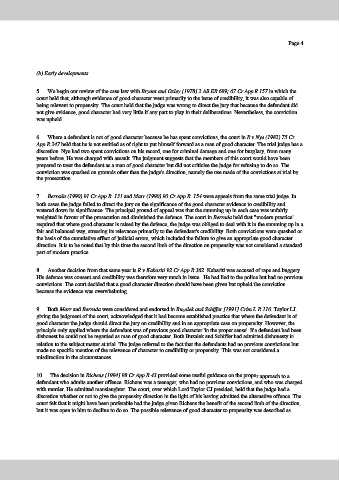Page 412 - Magistrates Conference 2019
P. 412
Page 4
(b) Early developments
5. We begin our review of the case law with Bryant and Oxley [1978] 2 All ER 689; 67 Cr App R 157 in which the
court held that, although evidence of good character went primarily to the issue of credibility, it was also capable of
being relevant to propensity. The court held that the judge was wrong to direct the jury that because the defendant did
not give evidence, good character had very little if any part to play in their deliberations. Nevertheless, the conviction
was upheld.
6. Where a defendant is not of good character because he has spent convictions, the court in R v Nye (1982) 75 Cr
App R.247 held that he is not entitled as of right to put himself forward as a man of good character. The trial judge has a
discretion. Nye had two spent convictions on his record, one for criminal damage and one for burglary, from many
years before. He was charged with assault. The judgment suggests that the members of this court would have been
prepared to treat the defendant as a man of good character but did not criticise the judge for refusing to do so. The
conviction was quashed on grounds other than the judge's direction, namely the use made of the convictions at trial by
the prosecution.
7. Berrada (1990) 91 Cr.App.R. 131 and Marr (1990) 90 Cr.App.R. 154 were appeals from the same trial judge. In
both cases the judge failed to direct the jury on the significance of the good character evidence to credibility and
watered down its significance. The principal ground of appeal was that the summing up in each case was unfairly
weighted in favour of the prosecution and diminished the defence. The court in Berrada held that "modern practice"
required that where good character is raised by the defence, the judge was obliged to deal with it in the summing up in a
fair and balanced way, stressing its relevance primarily to the defendant's credibility. Both convictions were quashed on
the basis of the cumulative effect of judicial errors, which included the failure to give an appropriate good character
direction. It is to be noted that by this time the second limb of the direction on propensity was not considered a standard
part of modern practice.
8. Another decision from that same year is R v Kabariti 92 Cr App R 362. Kabariti was accused of rape and buggery.
His defence was consent and credibility was therefore very much in issue. He had lied to the police but had no previous
convictions. The court decided that a good character direction should have been given but upheld the conviction
because the evidence was overwhelming.
9. Both Marr and Berrada were considered and endorsed in Buzalek and Schiffer [1991] Crim L R 116. Taylor LJ,
giving the judgment of the court, acknowledged that it had become established practice that where the defendant is of
good character the judge should direct the jury on credibility and in an appropriate case on propensity. However, the
principle only applied where the defendant was of previous good character 'in the proper sense'. If a defendant had been
dishonest he could not be regarded as man of good character. Both Buzalek and Schiffer had admitted dishonesty in
relation to the subject matter at trial. The judge referred to the fact that the defendants had no previous convictions but
made no specific mention of the relevance of character to credibility or propensity. This was not considered a
misdirection in the circumstances.
10. The decision in Richens [1994] 98 Cr App R 43 provided some useful guidance on the proper approach to a
defendant who admits another offence. Richens was a teenager, who had no previous convictions, and who was charged
with murder. He admitted manslaughter. The court, over which Lord Taylor CJ presided, held that the judge had a
discretion whether or not to give the propensity direction in the light of his having admitted the alternative offence. The
court felt that it might have been preferable had the judge given Richens the benefit of the second limb of the direction,
but it was open to him to decline to do so. The possible relevance of good character to propensity was described as

